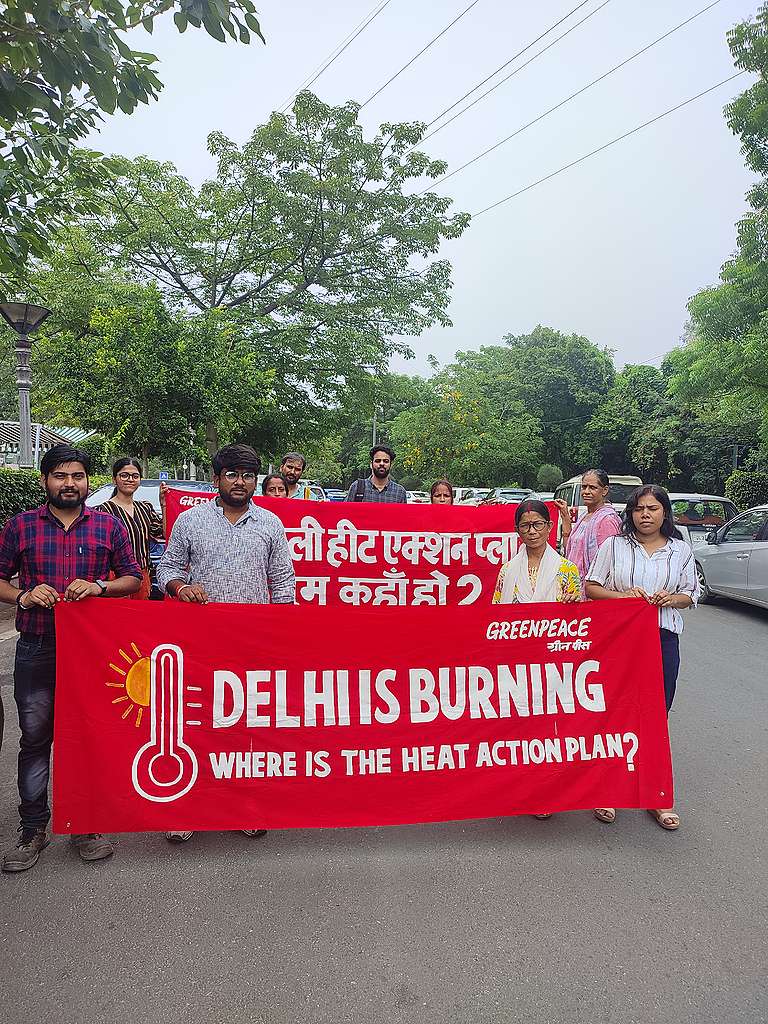
New Delhi: With deadly heat waves becoming a recurring problem in Indian cities and the national capital being among the worst impacted, Greenpeace activists unfurled a banner questioning the delay from the Delhi government in implementing the Heatwave Action Plan. With a banner reading “Delhi is Burning – Where is the Heat Action Plan”, activists held a demonstration outside the State Secretariat to highlight the urgency of the crisis. Following the demonstration, Greenpeace India released a follow-up letter addressed to the Chief Minister of Delhi, demanding the Heatwave Action Plan (HAP) draft be made available for public consultation before the end of June 2023—before being released and implemented. The HAP is crucial to safeguard Delhi and its citizens from the harmful impacts of extreme heat.
During April 2023, Greenpeace India and Heatwave Action Coalition (a network of intersectional youth climate groups) wrote to Chief Minister Arvind Kejriwal requesting the release of the Delhi Heat Action Plan (HAP) to combat the impacts of heatwaves in the city. However, even after two months, there is yet to be any action on the matter. Over this period, Delhi recorded 18 days when the temperature crossed 40°Celsius, which can have potentially deadly consequences for at-risk citizens without adequate support mechanisms.
“The absence of a heat wave action plan, despite the national guidelines, highlights a concerning lack of action from the Delhi government. With a population of over 18 million, including 11 million vulnerable citizens working in the informal sector, it is imperative for the Delhi government to release the Heatwave Action Plan without any delay. Protecting the health and livelihood of people from the devastating effects of heatwaves should be top priority,” says Avinash Chanchal, Campaign Manager, Greenpeace India.
According to the recent report by United in Science (which is coordinated by the World Meteorological Organisation), Delhi encountered five heatwaves between March and May in 2022. As a result, the city suffered severe impacts—both in terms of socioeconomic consequences and public health crisis. This year too, heat waves are causing devastation; Uttar Pradesh has reported 54 deaths while Bihar has recorded 42 deaths in just three days. Experts, including the Indian Meteorological Department, have warned that the upcoming months will likely be hotter than usual, with a high chance of heat waves hitting central and northwestern India.
“In Delhi, over 60 percent of residents are living in the informal parts of the city – becoming more vulnerable to heat. This includes migrant labourers fleeing climate-related impacts in their home regions, and becoming victims to another climate disaster in Delhi. Moreover, heat waves also pose massive risks to the elderly population and newborns. With the El Niño effect expected to bring even more extreme summers starting from mid-2023, we must act swiftly to avoid any further losses,” says Amruta S.N., Climate Campaigner at Greenpeace India.
Thus, Greenpeace India has proposed a comprehensive set of ten actionable demands to be included in the Delhi Heatwave Action Plan (HAP). These include the timely release of the HAP, incorporation of scientific climate projections based on local data from Delhi, the establishment of a sound early warning system, support for the most at-risk populations, policy integration and central funding, legally-binding mechanisms, provision of urgent healthcare for heatstroke victims, and the inclusion of nature-based cooling systems.
For more information contact
Avinash Kumar Chanchal, +91 8882153664, [email protected]
Nischita Verrendra, +91 9845828096, [email protected]
Mayank Jain Parichha, +91 9958528806, [email protected]
